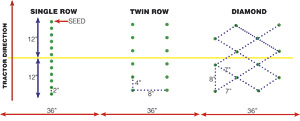This page has been archived and is being provided for reference purposes only. The page is no longer being updated, and therefore, links on the page may be invalid.
Read the magazine story to find out more. |
|
|
Diamond Planting Design for Peanut Crops
By Sharon DurhamFebruary 8, 2008
Agricultural Research Service (ARS) agronomists Russell Nuti and Ron Sorensen at the National Peanut Research Laboratory (NPRL) in Dawson, Ga., are adapting farm planting equipment to plant runner-type peanuts in a diamond formation.
This planting regimen has been found to increase yield and improve disease management in runner-type peanuts, compared to the single-row planting method often used by peanut farmers. This work was begun by former NPRL agricultural engineer Don Sternitzke.
In a diamond formation, each 3-foot-wide planting bed has four equidistant rows, with six seeds planted per foot. Spacing plants in this uniform, staggered manner has been found to reduce plant-to-plant competition and achieve canopy closure sooner, helping keep the soil cool and moist.
Now the researchers are testing the diamond planting scheme with a different type of peanut. In a new three-year study, conducted with Naveen Puppala and Sangu Angadi of New Mexico State University, researchers are using a more erect growing peanut type, the Valencia.
Valencia's upright growth habit may make this peanut type more amenable to the diamond planting arrangement than vine-like varieties grown in Georgia. According to Nuti, Valencia peanuts don't achieve row closure like runners do, especially when planted in single rows. However, in the diamond planting configuration the crop has a better chance to out-compete weeds, thus reducing early competition for water, nutrients, and light.
In first-year data collected, it appears several populations of diamond planting are equal in yield and profit to a twin-row configuration, and both diamond and twin-row configurations produce higher yields than does the conventional single row. It is apparent that higher seed input in twin row and diamond patterns increased yield and profit, according to Nuti.
Read more about this research in the February 2008 issue of Agricultural Research magazine.
ARS is the U.S. Department of Agriculture's chief scientific research agency.

